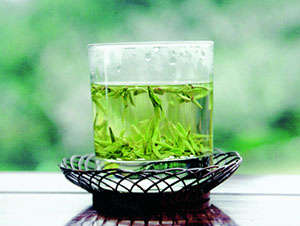AP English Class. Saint Johnsbury, VT. Friday Afternoon.
This time was always the highlight of the week, when everyone brought in snacks to share with the class and talked about the books they were reading.
I brought Tie Guan Yin, Iron Bodhisattva, one of my favorite kinds of oolong tea for my friends to enjoy. I tore open the vacuum-packed bag, tipped the pearl-shaped tea beads into a teapot, filled it with boiling water, let it brew for a few minutes, and poured it into everyone’s mug. As the tea beads uncurled in the heat, turning the water into an olivine color and sending forth the sweet aroma typical of oolong tea, someone held up a tea leaf she’d picked out of her mug and asked, “Is it spinach?”
I convinced her to take a sip, which in turn convinced her it was not spinach. Many classmates told me that the tea was amazingly delicious, but I also noticed that some hesitated before they drank from the mug with those spinach-looking leaves.
I didn’t feel offended or anything like that, because it was not the first time that I’d had to “defend” loose-leaf tea and demonstrate its worth outside China. Tea has always been a big part of my life. I grew up in Hangzhou, where one of the best kinds of green tea, Long Jing, or Dragon Well, is produced. Before going to Vermont for the last two years of high school, I filled my suitcases with my favorite kinds of tea, knowing that quality Chinese tea would be difficult to find there, as Americans haven’t been big on tea since the Boston Tea Party.
But I didn’t prepare myself for the fact that, even among those who enjoy drinking tea, not only do many accept tea bags as the norm, but they also think of loose-leaf tea as something bizarre. I have come across various reactions to the tea leaves in my mug or thermos, from stares and gasps to “this is like a cow eating grass”.
I was told that a tea bag makes life so much easier. You steep it in a mug, or a plastic cup, and throw it away after a couple of minutes before adding milk or sugar or honey to the tea. Only when you are feeling hip do you shop for “loose-leaf tea” and probably for an infuser or strainer, too, so that a stray tea leaf doesn’t end up in your mouth.
This is not the case in China. In fact, the term “loose-leaf tea” is redundant in Chinese. (Cha, the Chinese word for tea, automatically means loose-leaf tea.) In a tea shop or at the market, tea is sold by weight, and the clerks will offer you different samples until you find one kind that pleases you. “Bagged tea” is what you need to specify if you prioritize its convenience. Most Chinese people don’t think highly of bagged tea, because it lacks the subtle, mellow taste of “real tea”.
But does a bag really make such a big difference?
In fact, it’s not just the bag. The difference between loose-leaf tea and bagged tea lies in the production process and, consequently, the flavor.
Quality loose-leaf tea is made from hand-picked buds or whole leaves of tea trees. Not so with tea bags. I was startled to learn that the content of most tea bags consists of leaves and stems picked from tea plants regardless of their qualities, and then homogenized to maintain a standard for the final product. As if that weren’t bad enough, the tea leaves are shredded for the purpose of fast brewing and therefore turn bitter and puckery if steeped in hot water for too long.
Loose-leaf tea preserves the subtle flavor so much better. A handful of tea leaves can be re-steeped again and again and yield multiple cups without getting bland. The majority of leaves eventually sink to the bottom after a while, and a few stray leaves won’t choke you or fill your mouth with chewy bits. (Most Chinese tea, made from tender buds or leaves, is edible.)

Long Jing (Dragon Well), one of the best kinds of green tea
To me, tea drinking is not about consumption of caffeine but is an experience. I love watching the movement of tea leaves in the water, a ballet that tea in a bag will never be able to perform. Each kind of tea is different in shape, in color, and in the way it dances in the water. The tea buds of Yin Zhen, Silver Needle, float vertically when they first come into contact with the water. There is a kind of hand-crafted tea which blossoms in steaming water just like a flower bud opening in the warm spring air.
Even though now I don’t have exquisite tea sets with me at college, I still follow certain procedures: always boiling water in a kettle, preheating cups with hot water, brewing black tea and oolong tea with boiling water and green tea with water slightly cooler. Never milk. Never sugar. Only the pure fragrance and flavor.
Although conversion of the western frame of mind on tea seems like a long shot, I think I have succeeded in changing at least some of my friends’ attitude towards loose-leaf tea by preaching at them about its superiority and hounding them until they tasted my tea. After all, life is too short to waste on bad tea!